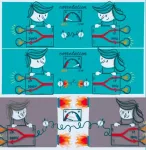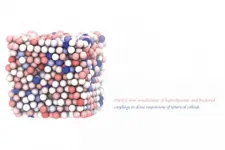The Modern Oral products have far fewer and significantly lower levels of toxicants‡ than cigarette smoke
Data demonstrates how BAT is building A Better Tomorrow™ by providing evidence to show how we are reducing the health impact of our business and delivering Tobacco Harm Reduction
London, 16 June: New research published today indicates that BAT's modern oral (MO) products in the form of tobacco-free nicotine pouches have a toxicant profile that is comparable to nicotine replacement therapies (NRTs) and much lower than traditional oral snus, a category of products that, when used as the sole nicotine product is already established as a reduced risk product compared with cigarettesi,ii.
The study, published in Drug and Chemical Toxicology, analysed four variants of one of BAT's MO nicotine pouch products Lyft+, three snus products, and two different NRT products in a lozenge and a gum format. Each of these products was tested for a range of known harmful and potentially harmful constituents (HPHCs).
The results showed that the MO products had a comparable toxicant profile to NRTs, which are currently considered to be the least risky of all nicotine products. The study also estimated that users of the studied MO products are likely to be exposed to far fewer and significantly lower levels of toxicants than those who use snus.
The findings suggest that MO products, such as Lyft and Velo, should be placed close to NRTs at the lowest exposure end of the nicotine product toxicant delivery continuum.
Dr Aaron Williams, Head of Science, R&D, said; "These results add to the growing body of evidence to support the reduced-risk potential of MO products compared to continuing to smoke.
"They provide important new evidence to support the role of MO products in Tobacco Harm Reduction by demonstrating that they have far fewer and much lower levels of toxicants compared with cigarette smoke and even compared with Swedish-style snus, which is already well established as a reduced risk product when used as the sole nicotine product. This means smokers looking for a alternative nicotine product have another alternative offering greatly reduced exposure to toxicants that comes in an oral format that some may find convenient and easy to use".
BAT is committed to building A Better TomorrowTM by reducing the health impact of its business through providing a range of enjoyable and lower risk products. The company continues to be clear that combustible cigarettes pose serious health risks, and the only way to avoid these risks is not to start or to quit. BAT encourages those who would otherwise continue to smoke, to switch completely to scientifically substantiated, reduced-risk alternatives*.
This study is a part of a comprehensive programme of scientific research designed to assess the reduced-risk potential of non-combustible nicotine products as compared to conventional cigarettes and traditional oral tobacco products.
Study Design The products in the study were analysed for 24-26 compounds relevant to oral tobacco products, including known harmful and potentially harmful constituents (HPHCs) from the FDA smokeless tobacco reporting list, and the GothiaTek® Standard list of toxicants used to ensure the quality of snus products. Also included were cigarette smoke toxicants (nine smoke constituents prioritised by the WHO's Tobacco Product Regulation Group, 'TobReg9', with the exception of carbon monoxide) not already included in the other lists.
For BAT's MO product, 22 of the 26 compounds tested were below measurable limits, with only moisture, nicotine, formaldehyde and chromium quantified at very low levels. Formaldehyde and chromium were present in some, but not all of the MO variants and only at extremely low levels. From a toxicological perspective, these extremely low levels of formaldehyde (estimated to be 0.004 mg/day for MO users) are unlikely to cause concern, as typical food consumption levels for adults is between 1.5 and 14 mg/day . For the NRT lozenge and gum, 22 and 20 of the 25 compounds were below measurable limits, with the others quantifiable at very low levels. In contrast, only 11 of the 24 compounds tested in the snus product were below measurable limits, whereas 13 compounds were present at quantifiable levels.
To evaluate the toxicant content of MO products in comparison to other tobacco and nicotine products on the risk continuum, we also reviewed the emissions data for 20 HPHCs from published studies of conventional cigarettes, a tobacco heating product (THP) and an e-cigarette. Cigarette smoke contained significant levels of 18 of the 20 measured compounds, THP aerosol contained 12 compounds at quantifiable levels, while e-cigarette vapor contained 7 compounds at quantifiable levels. The MO product had quantifiable levels of only 3 of these 20 HPHCs.
On its own, the toxicant content of a product is insufficient to establish potential health risks to a consumer, so we estimated daily exposure to toxicants for the different products based on average daily consumption of the toxicant. These data indicate that compared with smoking cigarettes, using these MO products would lower daily exposure to 16 of the 18 toxicants, and snus would lower exposure to 10 of the 18 toxicants.
Based on the measured toxicant contents and daily exposure estimates, these data suggest that the studied MO nicotine pouch products would likely fall between snus and NRTs on the toxicant continuum, having substantially lower levels than cigarettes, THPs, snus and vapour products. MO products may therefore provide a lower toxicant-exposure source of nicotine for current smokers who seek a complete substitute for continued smoking. The publication recognised the need for further research to be conducted to further expand the evidence base and the understanding of how MO products may contribute to Tobacco Harm Reduction.
INFORMATION:
About modern oral (MO) products
MO products are similar in appearance and use to snus, an oral smokeless tobacco product that has been widely used in Sweden since the 1800s.
There are decades of research (including epidemiology) on snus, with evidence demonstrating it is a reduced-risk product when used as a complete substitute for continued smoking of traditional cigarettes.
Consumers place the pouch between their gum and upper lip, typically for up to 30 minutes. During use, nicotine and flavours are released and the nicotine is absorbed through the oral mucosa in the gum.
BAT offers MO products with and without tobacco. Lyft and Velo contains high-purity, pharmaceutical-grade nicotine, water and high-quality food-grade ingredients, including plant fibres, flavouring and sweeteners. Velo does not contain tobacco (except in Japan where it contains 'white tobacco').
About BAT
BAT is a leading, multi-category consumer goods business, established in 1902. Our purpose is to build A Better Tomorrow™ by reducing the health impact of our business, which entails:
Committing to providing adult consumers with a wide range of enjoyable and less risky products
Continuing to be clear that combustible cigarettes pose serious health risks, and the only way to avoid these risks is not to start or to quit
Encouraging those who otherwise continue to smoke, to switch completely to scientifically substantiated, reduced-risk alternatives*
Tracking and sharing progress of our transformation
The company has announced a target of increasing the number of its non-combustible product consumers to 50 million by 2030; and to achieve at least £5 billion in New Categories revenues in 2025.
+Lyft is part of BAT's MO product family, which also comprises the flagship brand Velo. Products used in this study were Lyft Freeze, Lyft Lime Strong, Lyft Berry Frost and Lyft Mint
*Based on the weight of evidence and assuming a complete switch from cigarette smoking. These products are not risk free and are addictive.
†Our products as sold in the US, including Vuse, Velo, Grizzly, Kodiak, and Camel Snus, are subject to FDA regulation and no reduced-risk claims will be made as to these products without agency clearance.
‡This product is not risk-free and contains nicotine, an addictive substance. Comparison based on an assessment of smoke from a scientific standard reference cigarette (approximately 9mg tar) and components released during use of a Velo pouch, in terms of the average of the 9 harmful components the World Health Organisation recommends to reduce in cigarette smoke.
Enquiries
Press Office
+44 (0) 20 7845 2888 (24 hours) | @BATplc
Investor Relations
Mike Nightingale: +44 (0)20 7845 1180
Victoria Buxton: +44 (0)20 7845 2012
William Houston: +44 (0)20 7845 1138
John Harney: +44 (0)20 7845 1263
Forward-Looking Statements
This communication contains certain forward-looking statements, including "forward-looking" statements made within the meaning of the U.S. Private Securities Litigation Reform Act of 1995. These statements are often, but not always, made through the use of words or phrases such as "believe," "anticipate," "could," "may," "would," "should," "intend," "plan," "potential," "predict," "will," "expect," "estimate," "project," "positioned," "strategy," "outlook", "target" and similar expressions. These include statements regarding our intentions, beliefs or current expectations concerning, amongst other things, our results of operations, financial condition, liquidity, prospects, growth, strategies and the economic and business circumstances occurring from time to time in the countries and markets in which the BAT Group operates.
All such forward-looking statements involve estimates and assumptions that are subject to risks, uncertainties and other factors that could cause actual future financial condition, performance and results to differ materially from the plans, goals, expectations and results expressed in the forward-looking statements and other financial and/or statistical data within this communication.
Among the key factors that could cause actual results to differ materially from those projected in the forward-looking statements are uncertainties related to the following: the impact of competition from illicit trade; the impact of adverse domestic or international legislation and regulation; the inability to develop, commercialise and deliver the BAT Group's New Categories strategy; the impact of market size reduction and consumer down-trading; adverse litigation and dispute outcomes and the effect of such outcomes on the BAT Group's financial condition; the impact of significant increases or structural changes in tobacco, nicotine and New Categories related taxes; translational and transactional foreign exchange rate exposure; changes or differences in domestic or international economic or political conditions; the ability to maintain credit ratings and to fund the business under the current capital structure; the impact of serious injury, illness or death in the workplace; adverse decisions by domestic or international regulatory bodies; and changes in the market position, businesses, financial condition, results of operations or prospects of the BAT Group.
It is believed that the expectations reflected in this communication are reasonable, but they may be affected by a wide range of variables that could cause actual results to differ materially from those currently anticipated. Past performance is no guide to future performance and persons needing advice should consult an independent financial adviser. The forward-looking statements reflect knowledge and information available at the date of preparation of this communication and BAT undertakes no obligation to update or revise these forward-looking statements, whether as a result of new information, future events or otherwise. Readers are cautioned not to place undue reliance on such forward-looking statements.
No statement in this communication is intended to be a profit forecast and no statement in this communication should be interpreted to mean that earnings per share of BAT for the current or future financial years would necessarily match or exceed the historical published earnings per share of BAT.
Additional information concerning these and other factors can be found in BAT's filings with the U.S. Securities and Exchange Commission ("SEC"), including the Annual Report on Form 20-F and Current Reports on Form 6-K, which may be obtained free of charge at the SEC's website, http://www.sec.gov and the Company's Annual Reports, which may be obtained free of charge from the British American Tobacco website http://www.bat.com.
References
Fisher MT et al. Smokeless tobacco mortality risks: an analysis of two contemporary nationally representative longitudinal mortality studies. Harm Reduction Journal 2019; 16: 27. DOI: 10.1186/s12954-019-0294-6.
Tobacco Advisory Group of the Royal College of Physicians. Harm reduction in nicotine addiction: helping people who can't quit. London: Royal College of Physicians, 2007.
Azzopardi D, et al. Chemical characterisation of tobacco-free 'modern' oral nicotine pouches and their position on the toxicant and risk continuums. Drug & Chemical Toxicology 2021 https://doi.org/10.1080/01480545.2021.1925691..
WHO, 2001






